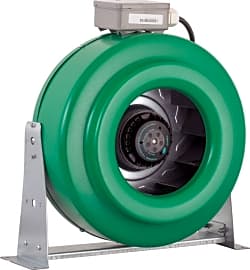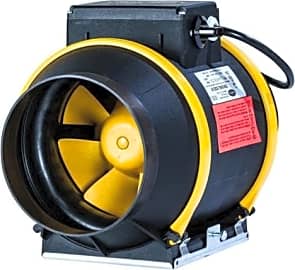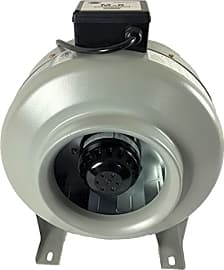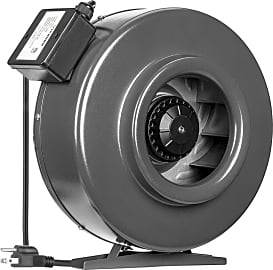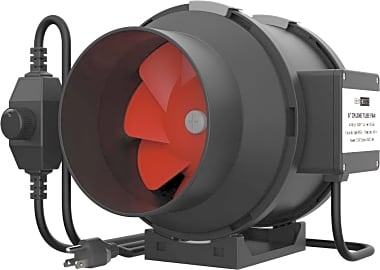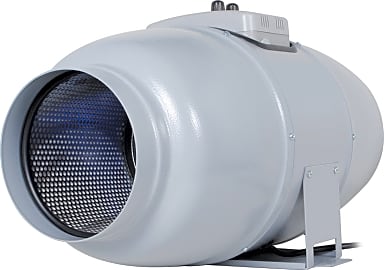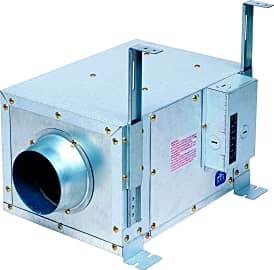The 10 Best Inline Vent Fans

This wiki has been updated 39 times since it was first published in June of 2016. Available in nominal, four- to 12-inch sizes, inline vent fans are designed to be connected with runs of rigid and flexible ductwork, allowing them to service areas where heavy air circulation is necessary. Our list includes small models, suitable for bathroom-exhaust applications, and big units that work great in large grow rooms that regularly generate surplus heat and humidity. When users buy our independently chosen editorial selections, we may earn commissions to help fund the Wiki.
Editor's Notes
December 09, 2020:
It was a fairly straightforward round of updates, as all of our picks for this category still proved to be excellent choices. We did, however, windup making a couple substantive changes.
First, we moved the Panasonic WhisperLine to the bottom of our list, recognizing that, while the WhisperLine presents a great option for users looking to incorporate a simple, bathroom exhaust fan during new-home construction or a bathroom renovation, it’s an impractical choice for grow rooms, and an unattractive choice for exposed installations of any sort. Even in the case of homes with central-exhaust systems and whole-house HRV units, the vast majority of the time you’ll likely be better off incorporating one of the heavy-duty units found further up our list. The WhisperLine also needs to be hardwired, which, for much of our audience, means that you might be stuck with the additional expense of calling in an electrician to handle the install.
Second, we removed the Terrabloom Booster, in order to make room for the Can-Fan 736748 Max-Fan Pro. While our former pick did present as a serviceable booster fan, capable of supplementing a more-powerful unit moving air through a particularly long run of ductwork, the reality is that you’d still be better served with a second heavy-duty fan, connected in series with the first. The only real reasons we could see recommending the Booster would be for users on a budget, or users with no other option than to incorporate a fan into an extremely small space (say a floor joist cavity that houses multiple runs of piping and ductwork).
Our replacement – the German-made Max-Fan Pro – is durable, powerful and easy to install. I’ve put a half-dozen of these units (some six- and some eight-inch) into grow rooms of various sizes, and always had great success. Like many models in this category, it’s a corded option, and it’s also capable of freestanding, thanks to one smooth side. So, if you aren’t the handiest gardener out there, but you need to increase your grow room's air circulation in a hurry, this is a great selection to consider; simply find a safe spot to lay it down (keep it off the floor, in case of any puddles, etc.), hook up a run of flexible ducting, plug it in, and you’ll be in business — although, you’ll likely want to make sure you’ve got an outlet timer or a temperature controller hooked up, as well.
While we’ve got you here, perhaps you’ll be interested in perusing some of our related rankings, such as Best Grow Tents, Best LED Grow Lights and Best T5 Grow Lights.
August 12, 2019:
We discovered that the Virtual Sun VS800F and Yescom Hydroponics were no longer available, so we took them off the list. We also removed the iPower Blower — a new version of this item is available, but its lifespan appears to be remarkably short, so we decided it does not warrant a place in these rankings.
Two of the three new additions to the list are available in multiple sizes, giving users plenty of variety to choose from. The Vtronic Flow has a clean, professional appearance, which is quite useful if it’s going to be installed in a visible location within a commercial greenhouse. Users are impressed with its quiet operation given its significant power. The Hurricane 745 is effective at both air circulation and odor removal, satisfying professionals using it for a variety of applications.
We dropped the Vivohome Black a few spots after finding some complaints regarding its noisy operation.
Special Honors
Apollo Horticulture A strong surface coating protects this small-but-mighty model from damage and corrosion as it works to create an environment that will enable your plant life to flourish. It has a built-in speed controller for keeping airflow at the optimal level, and it comes with mounting brackets. apollohorticulture.com
VENTS Quietline It should come as no surprise that this Quietline series focuses on low-noise fans. To achieve this, they’re designed with special airflow rectifiers on the exhaust spigot and rubber connectors around the motor to dampen sound. Depending on your needs, it offers four different modes of operation. ventilation-system.com
Quality Of Air Is Quality Of Life
Think about it — outdoors, air circulates naturally, creating an environment conducive to plant growth that we take for granted.
Unless your job requires it, you probably haven’t given a ton of thought the importance of quality air circulation in your home, workplace, or any other buildings you visit on a regular basis. Of course, you could be one of the rare individuals who has studied ventilation systems extensively out of innate curiosity…but for most of you, we’ll assume that’s not the case.
Simply put, ventilating a building is a critical process because it replaces stale, foul air with fresh, clean air. By continuously maintaining air circulation, exhaust fans can significantly enhance the comfort level for the occupants of a room. They remove excess moisture, dispel smoke, and eradicate unpleasant smells, making the air more refreshing and breathable.
In residential homes, exhaust fans primarily benefit kitchens and bathrooms, as these rooms tend to build up extra moisture, develop odors, and require the most temperature regulation. Basements, laundry rooms, and garages are also common locations for installing fans.
Because they remove water vapor and steam from the air, exhaust fans reduce relative humidity levels and therefore diminish the risk of mold and mildew development. This is one of the reasons you flip the fan on before you hop in the shower every morning.
If you’re an indoor gardener, a quality ventilation system will be one of the most vital components of your grow room or tent. Think about it — outdoors, air circulates naturally, creating an environment conducive to plant growth that we take for granted. Indoors, you have to do your part to recreate that environment.
In your grow room, the variation of a few degrees in temperature can be the difference between success and failure. Grow lights emit heat, and exhaust fans help to regulate the temperature in the room. As mentioned above, they also control the humidity level, which is essential for maintaining ideal growing conditions and preventing pests and diseases from interfering with your greenery.
Another factor you may have overlooked with outdoor plants is their exposure to wind; as gusts of air consistently jolt the plants, their stems strengthen over time. A fan can have the same effect. Think of it as a workout routine for your flowers and herbs — if you take away their gym membership, they’ll grow weaker and unhealthier as time passes.
Using Existing Ductwork To Your Advantage
Now you know the premise behind ventilation: good air in, bad air out. Which brings us to inline vent fans, a highly versatile solution for achieving the proper level of airflow in your home or grow room.
The difference between an inline vent fan and a standard exhaust fan is fairly straightforward. When installing a standard exhaust fan, you typically mount it just above the ceiling, connecting it to a vent that dispels the air it pulls from the room directly out of an opening in the roof.
Now you know the premise behind ventilation: good air in, bad air out.
Inline vent fans work in a similar fashion, except that you mount them directly to an existing duct, which makes them easy to install — you have plenty of options since you’re not restricted to the ceiling — and offers myriad other benefits.
For example, whereas each room may require its own standard fan, a single inline vent fan can account for multiple rooms. Say a kitchen, a laundry room, and a bathroom lie in close proximity to one another in a home — by installing an inline fan into a duct that connects the three rooms, you’ll create a more efficient, cost-effective ventilation system than a standard fan would have allowed.
Inline vent fans are also ideal for evening out temperature discrepancies between rooms, as they can move air along a long supply duct, heating or cooling a room that is disproportionately hot or cold compared to other areas of the house. These fans come in single port and multi-port styles, and the latter can easily provide ventilation for several rooms in the building.
Digging Into The Details Of Air Transfer
While inline vent fans usually operate on less power than standard fans, they do come in a variety of sizes and strengths. These units are rated by the volume of air they exchange, specifically in terms of cubic feet per minute.
Most of you will be dismayed to learn this, but determining the CFM rating you’re going to need will require a little bit of math. Don’t worry, it’s nothing on par with calculus, or even long division for that matter — a fairly straightforward equation will get the job done.
Most of you will be dismayed to learn this, but determining the CFM rating you’re going to need will require a little bit of math.
To calculate the CFM, you’ll need to know the total volume of the room and the exhaust efficiency. The first part is easy — simply measure out the dimensions of the room, then multiply the length by the width by the height.
The exhaust efficiency is a little trickier, as it depends on an array of factors, but a general rule of thumb is to multiply the total volume of the room by 1.25 for a reasonably accurate number. However, if your duct path is longer than normal, it’s probably safe to multiply the volume by up to two to make up for the efficiency drop as the air moves through the duct. Once you have this number, seek out a fan with a rating higher than that.
As most fan owners know, the process of pushing all that air can be a noisy undertaking. The most common unit for expressing sound level in the fan industry is the sone. A fan with a sone rating between 1.5 and four is fairly standard for a residential home, while you can expect to find fans with ratings up to 12 in larger establishments like restaurants and offices, and even higher ratings in commercial grow rooms and industrial settings.
Before you choose a fan, make sure you know exactly where you plan to install it. If you’re placing it into the ductwork directly connected to your kitchen, you may want to select a model with a relatively low sone rating so the noise doesn’t become irritating. If you plan to mount it in an attic or in a similar area that’s fairly removed from your living space, it’s probably safe to go with a somewhat louder model.



